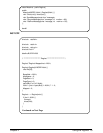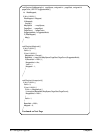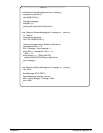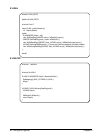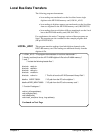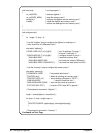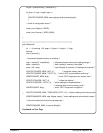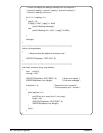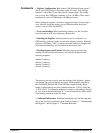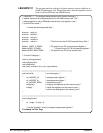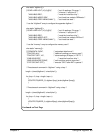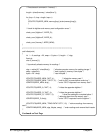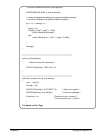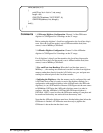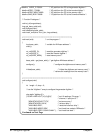
Comments 1. Digitizer Configuration. Both channel’s HI differential inputs (ports 3
and 4) are CONFigured for 10 readings on the 5V range. Two readings
(channel 1 and channel 2) are taken on each sample trigger. The sample
rate, as set by the CONFigure command, is 50 ns (20 MHz). Thus, data is
transferred at a rate of 40 MSamples (80 MBytes)/second.
Before setting the digitizer’s Local bus configuration the Local bus chip is
reset. Next, the Local bus mode is set to GENerate and the feed (data
source) is set to CONVerter:BOTH.
2. Post-Arm Readings. When transferring readings over the Local bus
from the digitizer A/D, all readings must be post-arm.
3. Initiating the Digitizer. After the memory card is configured, it is
INITiated first so that it is ready to receive the digitizer readings. When the
digitizer is INITiated, *OPC? is used to allow the readings to complete and
be transferred before they are retrieved from the memory card.
4. Reading Sequence and Format. When this program executes, the
readings are transferred to the memory card and later displayed in the
following sequence:
channel 2 reading 1
channel 1 reading 1
channel 2 reading 2
channel 1 reading 2
.
.
.
The memory card was set up to store the readings in the digitizer’s packed
data format. The packed readings are signed, 16-bit numbers preceded by
the ANSI/IEEE Standard 488.2-1987 Definite Length Arbitrary Block
header. Packed readings are always numbers between -1.0230 (-2046) and
+1.0235 (2047). To convert the readings to voltages, each reading is divided
by 16 to remove the data label bits (0 - 3), and is multipled by 0.0025 which
is the reading resolution for the 5V range.
5. Additional Information. Additional information on Local bus operation
and on the Local bus commands can be found in Chapter 3 - "Understanding
the Digitizer", and in Chapter 4 - "Command Reference."
Chapter 2 Usin
g
the Di
g
itizer 87



